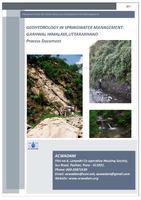Items
Tag
Water quality monitoring
-
 Aquifer Mapping Process The aquifer mapping process involves several key steps to assess groundwater resources effectively. It begins with reconnaissance to analyze regional groundwater dependence using various data sources. Surveys follow, including geological mapping and well inventories, supported by geophysical surveys to enhance data accuracy. Groundwater levels and quality are then monitored regularly to gather seasonal insights. The process culminates in aquifer conceptualization, where data is overlaid to create a comprehensive aquifer map detailing characteristics like storage, quality, and recharge potential. Finally, ongoing monitoring and adjustments are made to manage groundwater sustainably and address any emerging issues.
Aquifer Mapping Process The aquifer mapping process involves several key steps to assess groundwater resources effectively. It begins with reconnaissance to analyze regional groundwater dependence using various data sources. Surveys follow, including geological mapping and well inventories, supported by geophysical surveys to enhance data accuracy. Groundwater levels and quality are then monitored regularly to gather seasonal insights. The process culminates in aquifer conceptualization, where data is overlaid to create a comprehensive aquifer map detailing characteristics like storage, quality, and recharge potential. Finally, ongoing monitoring and adjustments are made to manage groundwater sustainably and address any emerging issues. -
 Case Study of Garhwal Springs The document focuses on the geohydrology of springwater management in the Garhwal Himalaya region of Uttarakhand, highlighting the challenges faced by local communities in accessing reliable water sources. Despite being the origin of major rivers, residents in the Himalayas often experience water shortages, primarily relying on springs for their drinking and domestic needs. The Himmotthan Initiative, in partnership with ACWADAM, aims to improve catchment area planning for spring water management through geohydrological studies, training programs, and community engagement. Key aspects of the initiative include detailed hydrogeological investigations of selected springs, which encompass assessing spring discharge, water quality, and appropriate recharge measures. The study identifies four springs in the region, analyzing their geological settings and discharge patterns. Recommendations for enhancing spring discharge, protecting aquifers, and training local stakeholders in water data collection are integral parts of the initiative. The document emphasizes the necessity for a collaborative approach to address the social and administrative challenges encountered in implementing effective spring management practices. In conclusion, the pilot studies underscore the significance of hydrogeological assessments in spring development and management, showcasing how targeted treatment measures can lead to improved water availability. Continuous capacity building and community involvement are essential for sustaining spring recharge initiatives, as they empower local organizations to monitor and manage water resources effectively. The insights gained from this study not only contribute to the understanding of spring hydrology but also highlight the importance of integrating scientific knowledge with community needs for effective water resource management in the Himalayas.
Case Study of Garhwal Springs The document focuses on the geohydrology of springwater management in the Garhwal Himalaya region of Uttarakhand, highlighting the challenges faced by local communities in accessing reliable water sources. Despite being the origin of major rivers, residents in the Himalayas often experience water shortages, primarily relying on springs for their drinking and domestic needs. The Himmotthan Initiative, in partnership with ACWADAM, aims to improve catchment area planning for spring water management through geohydrological studies, training programs, and community engagement. Key aspects of the initiative include detailed hydrogeological investigations of selected springs, which encompass assessing spring discharge, water quality, and appropriate recharge measures. The study identifies four springs in the region, analyzing their geological settings and discharge patterns. Recommendations for enhancing spring discharge, protecting aquifers, and training local stakeholders in water data collection are integral parts of the initiative. The document emphasizes the necessity for a collaborative approach to address the social and administrative challenges encountered in implementing effective spring management practices. In conclusion, the pilot studies underscore the significance of hydrogeological assessments in spring development and management, showcasing how targeted treatment measures can lead to improved water availability. Continuous capacity building and community involvement are essential for sustaining spring recharge initiatives, as they empower local organizations to monitor and manage water resources effectively. The insights gained from this study not only contribute to the understanding of spring hydrology but also highlight the importance of integrating scientific knowledge with community needs for effective water resource management in the Himalayas.